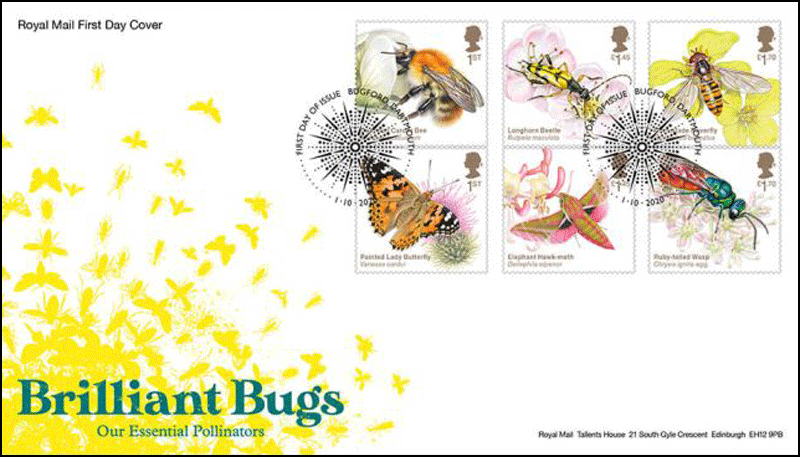[press release]
It’s A Bug’s Life!
New Special Stamps from Royal Mail Celebrate Pollinating Insects of The UK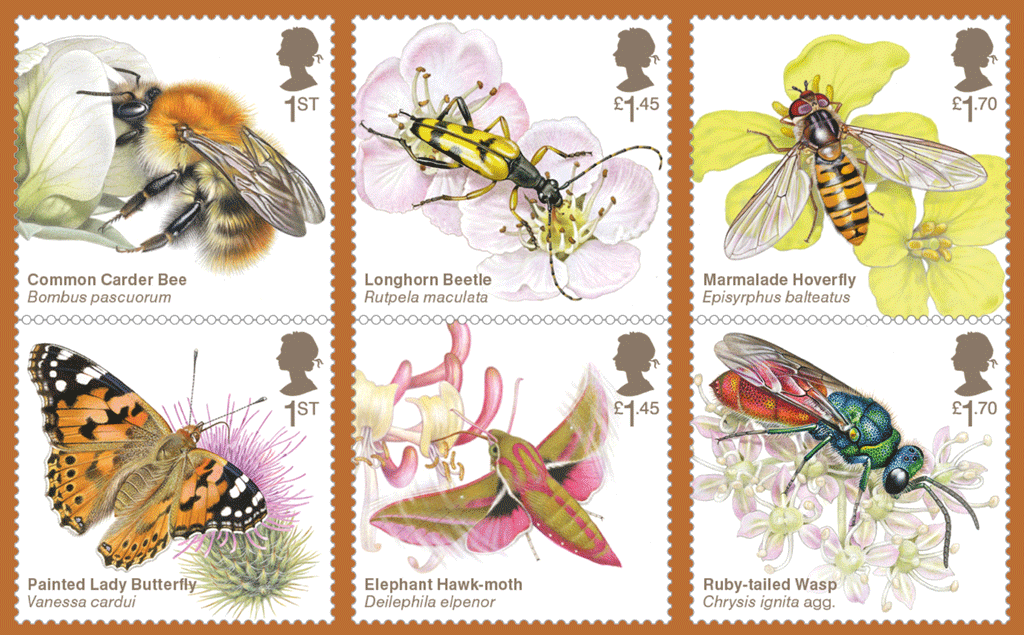
- Royal Mail today launches a set of Special Stamps that celebrate the diversity, intrigue and importance of pollinating insects in the UK
- Entitled ‘Brilliant Bugs’, the stamps celebrate pollinators and explore bees and butterflies – and other often overlooked important pollinators including moths, beetles, hoverflies and wasps
- Six important insect pollinators are featured: Common Carder Bee; Painted Lady Butterfly; Longhorn Beetle; Elephant Hawk-moth; Marmalade Hoverfly; and Ruby-tailed Wasp
- Pollinators are responsible for pollination of vast quantities of food crops for humans and farm animals and the pollination of wild plants including flowers and some trees
- There are thought to be more than five million species of these ‘brilliant bugs’ worldwide, although, there is growing evidence the numbers of insects, including some pollinators, are declining
- Royal Mail worked with ecologist and entomologist, Professor Helen Roy MBE, from the UK Centre for Ecology & Hydrology, on the stamp set
- The stamps were illustrated by Oxfordforshire-based, wildlife artist, Richard Lewington
- The full set of six stamps, available in a Presentation Pack, retails at £8.70. The stamps and a range of collectible products are available now from www.royalmail.com/brilliantbugs
Royal Mail has launched a set of six stamps that celebrate the diversity, intrigue and importance of insects which pollinate plants in the UK.
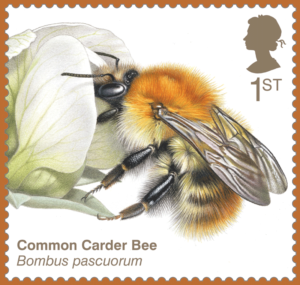 The stamps explore insects — including bees and butterflies — and other often overlooked important pollinators, including moths, beetles, hoverflies and wasps.
The stamps explore insects — including bees and butterflies — and other often overlooked important pollinators, including moths, beetles, hoverflies and wasps.
Featured are six important insect pollinators feeding on flowers they typically visit: Common Carder Bee; Painted Lady Butterfly; Longhorn Beetle; Elephant Hawk-moth; Marmalade Hoverfly; and Ruby-tailed Wasp.
Pollinators are responsible for pollination of vast quantities of food crops for humans and farm animals and the pollination of wild plants including flowers and some trees. Of all plants worldwide, more than 85% are pollinated by insects and other animals.
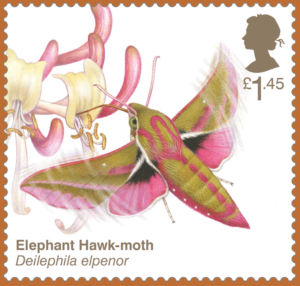 There are thought to be more than five million species of these ‘brilliant bugs’ worldwide.
There are thought to be more than five million species of these ‘brilliant bugs’ worldwide.
Bees are the main pollinators in most ecosystems; there are over 20,000 species worldwide and more than 250 are found in the UK. Flies are considered the second most important group of pollinators; there are a staggering 120,000 species of fly worldwide. In addition to bees and flies, some species of butterfly, moth, wasp, beetle as well as thrip, are also considered important visitors to flowers.
There have been many reports that pollinating insects are undergoing significant declines around the world. Many reasons are given for these declines – from climate change to how we manage landscapes. A recent study in Britain showed that, over the last three 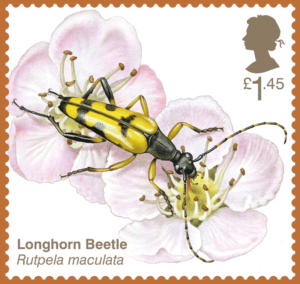 decades, one third of bee and hoverfly species have declined.
decades, one third of bee and hoverfly species have declined.
To combat the declines, farmers around the world are putting flower-rich habitats back on the land they manage. Consequently, they are seeing an increase in the number of pollinating insects.
We can increase the numbers of flowers in urban landscapes by growing plants attractive to pollinating insects. There are many to choose from, including cowslips, bugle and heathers.
Vetches, dandelions, clovers and many of the flowers that appear in lawns also provide a rich source of nectar for pollinating insects – so patches of unmown lawn can be beneficial.
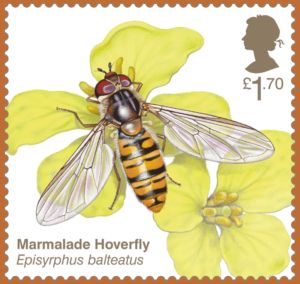 Royal Mail worked with ecologist and entomologist Professor Helen Roy MBE, from the UK Centre for Ecology & Hydrology, on the stamp set.
Royal Mail worked with ecologist and entomologist Professor Helen Roy MBE, from the UK Centre for Ecology & Hydrology, on the stamp set.
Professor Roy, said: “Insects are captivating, and I was delighted to be invited to join Royal Mail in celebrating insect pollinators.”
The stamps were illustrated by Oxfordshire-based, renowned wildlife artist, Richard Lewington.
Richard said: “At a time when the plight of insects as pollinators has much been in the news, I was delighted to be commissioned by Royal Mail, to highlight the importance and incredible diversity of 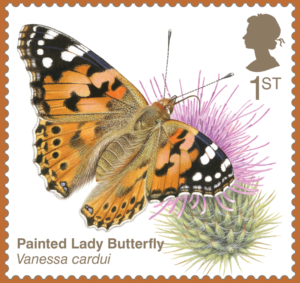 ‘Brilliant Bugs’.
‘Brilliant Bugs’.
Philip Parker, Royal Mail said: “Our exquisite new stamps depict colourful insects feeding on some of the flowers they frequent. We mark the vital role they play in pollinating wild flowers and crops: from bees and butterflies to the often-underappreciated work of hoverflies, moths, wasps and beetles.”
Stamp by stamp:
Common Carder Bee (Bombus pascuorum)
Depicted on large blue pea flower. One of the 24 species of bumblebee that live in the UK, this ginger-coloured bee can be found in many different habitats including gardens.
Painted Lady Butterfly (Vanessa cardui)
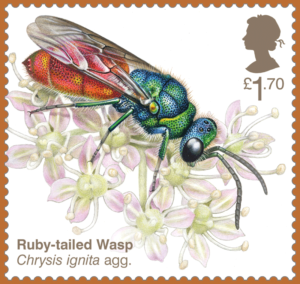 Depicted on thistle. This migratory butterfly travels vast distances from the Middle East and Central Asia before arriving in the UK during the summer months.
Depicted on thistle. This migratory butterfly travels vast distances from the Middle East and Central Asia before arriving in the UK during the summer months.
Longhorn Beetle (Rutpela maculate)
Depicted on flowering hawthorn. This species lives for several years in its larval stage feeding on decaying wood, finally emerging as the striking, wasp-mimicking adult illustrated on the stamp to live for between two and four weeks.
Elephant Hawk-moth (Deilephila elpenor)
Depicted on honeysuckle. More than 2500 species of moth have been recorded in the UK. The elephant hawk-moth’s pink and green wings span 45-60mm.
Marmalade Hoverfly (Episyrphus balteatus)
Depicted on oilseed rape. In the UK there are more than 280 species of hoverfly. Favouring flat-topped flowers to land and fed on, it is commonly seen in gardens and is an important pollinator of crops.
Ruby-tailed Wasp (Chrysis ignita agg.)
Depicted on angelica. While the adult ruby-tailed wasp feeds on the nectar of flowers, the young larvae eat the eggs and larvae of other insect species.
The full set of six stamps, available in a Presentation Pack, retails at £8.70.
The stamps and a range of collectible products are available at: www.royalmail.com/brilliantbugs